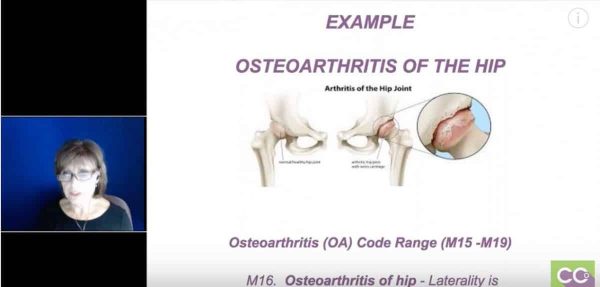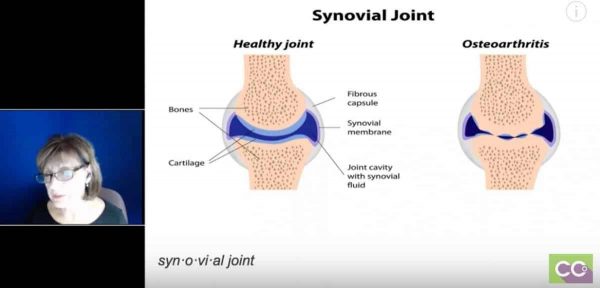M
Mayenne Perpetua
Guest
Visit [CCO] Certification Coaching Organization LLC for more articles about [CCO] Certification Coaching Organization LLC - Medical Certifications - Learn It - Get Certified - Stay Certified.
Q: “Can we discuss coding osteoarthritis? I often see it diagnosed as osteoarthritis with a specified site but not if it is primary or secondary.”
A: This one is pretty simple. A primary osteoarthritis is considered wear and tear, and is the most frequently diagnosed by healthcare providers. Secondary osteoarthritis has a specific cause, such as an injury or resulting from obesity, genetics, inactivity or other diseases. Then, there’s also post-traumatic osteoarthritis, which is the wearing out of a joint that has had any kind of physical injury.
What exactly is osteoarthritis? It’s the breakdown of cartilage causing the bones to react to those areas, often developing bone spurs or growths. The joints may become inflamed and swollen. When the bones touch without the protective cartilage, pain and stiffness result. When we’re coding for osteoarthritis, we have a site and laterality designations.
VIDEO: How to Determine if OS Site is Primary or Secondary
I find that doctors such as orthopedics, podiatrist, chiropractors, they tend to be much more specific with laterality and the site; however, primary care has a tendency to just write osteoarthritis.
Primary osteoarthritis typically develops around 55-60 and it is associated with aging. The longer you use your joints, the more likely you are to get this type of arthritis.
Secondary osteoarthritis is either from an injury, if you fracture a bone playing sports or are in a motor vehicle accident, you will most likely develop osteoarthritis in that joint. Obesity – the extra weight bears down on the joints every day causing the joint to wear away faster. Inactivity – if you are inactive, you have weaker muscles and tendons that surround the joint. Strong muscles keep the joints properly aligned.
Genetics – you may carry genes that put you at risk. Then, inflammation from other diseases – rheumatoid arthritis can increase your risk of getting osteoarthritis later in life.
 The next page is a picture of osteoarthritis of the hip. You can actually look at the two and you can see the difference between the normal side of the hip and the one with the osteoarthritis. The code range for osteoarthritis is M15 to M19. I just happened to pick the M16 – osteoarthritis of the hip, and the laterality is identified within the category. This is not even all of them, I just picked these particular codes just to show you how they’re labeled.
The next page is a picture of osteoarthritis of the hip. You can actually look at the two and you can see the difference between the normal side of the hip and the one with the osteoarthritis. The code range for osteoarthritis is M15 to M19. I just happened to pick the M16 – osteoarthritis of the hip, and the laterality is identified within the category. This is not even all of them, I just picked these particular codes just to show you how they’re labeled.
M16.0 will be bilateral primary osteoarthritis of the hip, and then .10 is the unilateral primary, unspecified hip; .11 is primary unilateral, right hip; .12 is unilateral primary, left hip; .4 is unilateral post-traumatic, unspecified hip; and .7 is secondary arthritis of hip, other unilateral. There are a lot more in the M16 as well as the other codes, but I just wanted to point out those key words: primary, post-traumatic, and secondary.
Now, what you need to look for and one of the things you learn with ICD-10 is that you’re not only learning the coding, but you’re also learning the pathophysiology. First, when you’re looking at the documentation, before you query the physician, wanted to see if it’s in the documentation, is the hip, the knee, the carpometacarpal joint? Does it indicate in the documentation, even if the doctor just chose osteoarthritis, if it’s left, right or bilateral?
If the physician does not provide information regarding being primary, secondary, or
post-traumatic, you may reference that in the note. He may indicate age, or wear and tear. He may indicate that the patient is obese and gives a body mass index and so forth. You may be able to determine from the documentation if it’s a primary or secondary. Does the note indicate stiffness or joint enlargement? Is there lab work indicating a white blood count or x-rays taken? Things like that.
If you cannot figure it out based on this type of information, then you have to query the physician. I can tell you firsthand that these unspecified codes are not going well with the insurance companies so you really want to be specific.
 In the last slide it will show the synovial joint, and again, it just shows you what a healthy joint looks like and then when you look at the osteoarthritis illustration, you can look at where the cartilage is not there and the whole joint cavity with synovial fluid is just very thin, so the bones rubbing together and that’s basically what it is.
In the last slide it will show the synovial joint, and again, it just shows you what a healthy joint looks like and then when you look at the osteoarthritis illustration, you can look at where the cartilage is not there and the whole joint cavity with synovial fluid is just very thin, so the bones rubbing together and that’s basically what it is.
So, the primary is wear and tear, secondary is due to a lot of other factors. If you can’t determine based on documentation, I would query the doctor unless you want to use unspecified. They’re there, but as a biller, I don’t recommend it. It’s a pain to have to appeal a claim and they’re not liking the unspecified diagnosis codes in most cases.
Laureen: That was one of the questions in the chat. If they just say osteoarthritis, do you code it as unspecified? Your advice is to query the physician, but if you can’t do that then you have to go with unspecified, right?
JoAnne: Right. Again, it really depends on the insurance company, but I can tell you 8 out of 10 times any unspecified codes that the billers that I know used end up having to appeal the claim, that insurances don’t like it, particularly when it comes to the bones. Just saying. That’s pretty much it.
Laureen: Thanks JoAnne.
JoAnne: You’re welcome.
Related How to Determine if OS Site is Primary or Secondary Posts:

The post How to Determine if OS Site is Primary or Secondary? appeared first on [CCO] Certification Coaching Organization LLC.
Continue reading...
Q: “Can we discuss coding osteoarthritis? I often see it diagnosed as osteoarthritis with a specified site but not if it is primary or secondary.”
A: This one is pretty simple. A primary osteoarthritis is considered wear and tear, and is the most frequently diagnosed by healthcare providers. Secondary osteoarthritis has a specific cause, such as an injury or resulting from obesity, genetics, inactivity or other diseases. Then, there’s also post-traumatic osteoarthritis, which is the wearing out of a joint that has had any kind of physical injury.
What exactly is osteoarthritis? It’s the breakdown of cartilage causing the bones to react to those areas, often developing bone spurs or growths. The joints may become inflamed and swollen. When the bones touch without the protective cartilage, pain and stiffness result. When we’re coding for osteoarthritis, we have a site and laterality designations.
VIDEO: How to Determine if OS Site is Primary or Secondary
I find that doctors such as orthopedics, podiatrist, chiropractors, they tend to be much more specific with laterality and the site; however, primary care has a tendency to just write osteoarthritis.
Primary osteoarthritis typically develops around 55-60 and it is associated with aging. The longer you use your joints, the more likely you are to get this type of arthritis.
Secondary osteoarthritis is either from an injury, if you fracture a bone playing sports or are in a motor vehicle accident, you will most likely develop osteoarthritis in that joint. Obesity – the extra weight bears down on the joints every day causing the joint to wear away faster. Inactivity – if you are inactive, you have weaker muscles and tendons that surround the joint. Strong muscles keep the joints properly aligned.
Genetics – you may carry genes that put you at risk. Then, inflammation from other diseases – rheumatoid arthritis can increase your risk of getting osteoarthritis later in life.

M16.0 will be bilateral primary osteoarthritis of the hip, and then .10 is the unilateral primary, unspecified hip; .11 is primary unilateral, right hip; .12 is unilateral primary, left hip; .4 is unilateral post-traumatic, unspecified hip; and .7 is secondary arthritis of hip, other unilateral. There are a lot more in the M16 as well as the other codes, but I just wanted to point out those key words: primary, post-traumatic, and secondary.
Now, what you need to look for and one of the things you learn with ICD-10 is that you’re not only learning the coding, but you’re also learning the pathophysiology. First, when you’re looking at the documentation, before you query the physician, wanted to see if it’s in the documentation, is the hip, the knee, the carpometacarpal joint? Does it indicate in the documentation, even if the doctor just chose osteoarthritis, if it’s left, right or bilateral?
If the physician does not provide information regarding being primary, secondary, or
post-traumatic, you may reference that in the note. He may indicate age, or wear and tear. He may indicate that the patient is obese and gives a body mass index and so forth. You may be able to determine from the documentation if it’s a primary or secondary. Does the note indicate stiffness or joint enlargement? Is there lab work indicating a white blood count or x-rays taken? Things like that.
If you cannot figure it out based on this type of information, then you have to query the physician. I can tell you firsthand that these unspecified codes are not going well with the insurance companies so you really want to be specific.

So, the primary is wear and tear, secondary is due to a lot of other factors. If you can’t determine based on documentation, I would query the doctor unless you want to use unspecified. They’re there, but as a biller, I don’t recommend it. It’s a pain to have to appeal a claim and they’re not liking the unspecified diagnosis codes in most cases.
Laureen: That was one of the questions in the chat. If they just say osteoarthritis, do you code it as unspecified? Your advice is to query the physician, but if you can’t do that then you have to go with unspecified, right?
JoAnne: Right. Again, it really depends on the insurance company, but I can tell you 8 out of 10 times any unspecified codes that the billers that I know used end up having to appeal the claim, that insurances don’t like it, particularly when it comes to the bones. Just saying. That’s pretty much it.
Laureen: Thanks JoAnne.
JoAnne: You’re welcome.
Related How to Determine if OS Site is Primary or Secondary Posts:
- Emergency Department Visits Diagnoses Medical Coding Guidelines
- Correct Coding Sequence of Vaccine Administration Codes
- ICD 10 Impact on Risk Adjustment | Risk Adjustment Training

The post How to Determine if OS Site is Primary or Secondary? appeared first on [CCO] Certification Coaching Organization LLC.
Continue reading...
